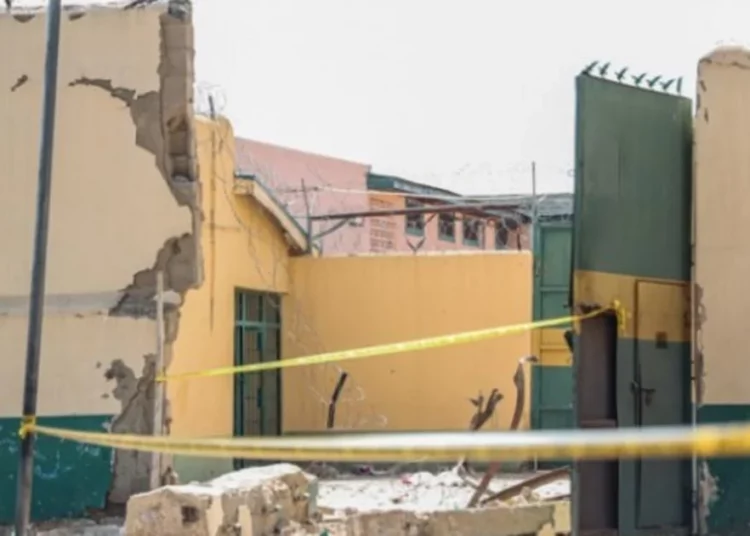Nigeria again suffered one of its most humiliating security failures as 16 inmates escaped from the Medium Security Custodial Centre, Keffi, in the early hours of Tuesday.
The well-coordinated attack saw prisoners overpowering guards, injuring five correctional officers, two of whom are in critical condition and receiving treatment at a government hospital.
Nigeria’s prison system has suffered recurring jailbreaks and has a staggering death‑row population.
Over the years, these issues have exposed systemic weaknesses ranging from security failures to judicial bottlenecks, raising questions about public safety and institutional reform.
From repeated jailbreaks to failing surveillance systems, Nigeria’s maximum-security prisons are no longer living up to their name. This report takes a deep look at a crumbling correctional system, where even the most dangerous inmates are one breach away from freedom.
RELATED: Nigeria Records Third Jailbreak In 2025 As 16 Inmates Flee Keffi Prison
Interestingly, despite the high number of jailbreaks recorded in the last 10 years, LEADERSHIP Weekend gathered that death-row inmates escaped during these events.
Abuja prison jailbreak lasted 3 hours
When heavily armed insurgents stormed the Kuje Custodial Centre, Abuja, on July 5, 2022, they spent nearly three hours moving through the heart of Nigeria’s most “secure” prison unhindered by alarms, undetected by cameras, and virtually unchallenged by on-duty personnel.
By the time the dust settled, 879 inmates had escaped, including 64 suspected Boko Haram terrorists and 36 death-row inmates. The attack, later claimed by ISWAP, was not only a national embarrassment but also a chilling reminder that even the most fortified prisons in Nigeria are frighteningly vulnerable.
Other major incidents which occurred in Owerri (2021), Benin/Oko (2020), Jos (2021), Agodi (2012), and Kabba (2021) involved large numbers of escapees, but none included documented death‑row inmates.
Nigerians often assume that maximum-security prisons like Kuje (Abuja), Kirikiri (Lagos), and Port Harcourt are fortified against any internal or external threats.
But multiple jailbreaks have revealed an ugly truth: these facilities — some over 60 years old — suffer from underfunding, ageing infrastructure, and gaping security lapses.
In the Kuje case, our correspondent gathered that all the15 CCTV cameras were not functioning at the time of the attack.
A very reliable source also said that the alarms never sounded. The perimeter fencing was also said to have been compromised. And perhaps most damning: there were only four armed personnel present during the attack against nearly 100 gunmen.
A senior Nigeria Correctional Service (NCoS) official who asked not to be named said, “There was no functioning CCTV system, no alarms went off. Everything failed. What we have are prisons running on 1990s systems in a 2025 threat environment.”
LEADERSHIP Weekend writes that while the Nigerian Correctional Service receives federal allocations for security infrastructure, insiders and audits reveal a persistent failure to install or maintain modern surveillance equipment in major facilities.
When asked why CCTV cameras and alarm systems remain non-functional in several maximum-security prisons, the NCoS attributed it to: “budgetary limitations, delayed procurement processes, and vandalism by inmates during past unrests which have affected the stability of our surveillance systems. We are working with the Ministry of Interior and security agencies to address this.”
However, security experts argue that a lack of political will and corruption are also to blame.
“Surveillance equipment is bought but never installed. Contracts are awarded without follow-through. No one is held accountable,” said a retired official of the Directorate of State Services (DSS), Nigeria’s secret police.
Kuje wasn’t an isolated event. It was part of a wider trend that has seen over 7,200 inmates escape from Nigerian prisons between 2019 and 2025. In many of these cases — Benin (2020), Jos (2021), Kabba (2021), Owerri (2021), there were no functioning surveillance systems, the guard ls on duty were insufficient and response times were slow.
So far, according to available records, the number of death-row inmates who successfully escaped remains zero — aside from the Kuje breakout, where they remain unaccounted for but not confirmed as escaped.
A top source at the Service’s headquarters, who preferred not to be named, told our correspondent that the locations of escaped inmates and the various security lapses had been identified.
He said that in 2022, 879 inmates escaped from Kuje (Abuja) due to the absence of CCTV and alarms, an ugly scenario that led to the death of four armed guards.
He said in 2021, 240 out of 266 inmates escaped from Kabba (Kogi), with two guards killed after the gate was blown open.
In 2021 at Owerri (Imo State), 1,844 inmates escaped, which was attributed to external attacks that led to the guards being overwhelmed. Also in 2020 at Benin/Oko (Edo State), 1,993 inmates escaped when the prison was overrun during the #EndSARS protest.
The source added that while the system fails, ordinary citizens bear the risk. Communities near jailbreak sites live in fear. Victims of escaped convicts live in renewed trauma. And justice, already slow in Nigeria, takes another step backward.
Another top source at the Service’s headquarters identified institutional impunity and the “revolving door” as part of the problem.
“Look at it this way,” he said, “despite the frequency of prison breaks, no major official has been prosecuted for dereliction of duty.
“Investigative panels are set up, reports are filed, and promises are made — yet the same problems persist: under-equipped staff, poor funding, and zero deterrent for failure.”
LEADERSHIP Weekend reports that though the NCoS has repeatedly called for greater funding and modernisation, including the adoption of biometrics, AI-powered surveillance, and 24/7 armed patrols, little has changed on the ground.
A security expert, Mr. Uto-Obong Edwok, said that until prisons are treated as critical national infrastructure, and until security gaps are plugged and oversight enforced, maximum security prisons will remain a label, not a reality.
He said, “What makes a prison ‘maximum security’ is the fact that it should be 24/7 protected by armed guard patrols. It should have double-layer fencing with sensors, electronic locks, and surveillance cameras.
“It should have restricted access zones and inmate movement should be controlled. It should have backup power for alarms and security systems, but it’s so sad that in Nigeria, many of the so-called ‘maximum-security’ facilities meet less than half of these criteria.
“I want to leave our leaders with this message: if the walls of justice are made of brick and law, Nigeria’s are cracking at the seams. And each escape isn’t just a prisoner gaining freedom, it’s a message that the state has failed.”
The public relations officer of the Nigeria Correctional Service (NCoS), DCC Umar Abubakar, could not be reached for reactio as his line was breaking due to network fluctuations.
Messages sent to his mobile number via SMS and WhatsApp were also undelivered as of press time.





